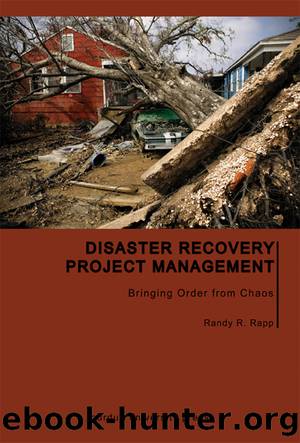Disaster Recovery Project Management by Randy R. Rapp

Author:Randy R. Rapp
Language: eng
Format: epub
Tags: Disaster Recovery Project Management: Bringing Order from Chaos
Publisher: Purdue University Press
Published: 2011-09-13T00:00:00+00:00
PROCUREMENT
The procurement function tries to maximize the value derived from all funds invested to obtain goods and services. This occurs by reducing the cost and using more effectively whatever is obtained. Chapter 3 discussed this function as part of a contractorâs value chain. Procurement is much more than just purchasing or buying. It demands that the project establish requirements, purchase, expedite, control and assure quality, and administer documents and processes (Stukhart 1995, 82).
Figure 8.2. Multiyear recovery projects might justify the construction of a warehouse on-siteâas this one for the program to restore the Iraqi oil infrastructure. The warehouse affords protection from theft and damage, and it facilitates quick and accurate processing of incoming shipments.
The lowest unit cost for materials may not be the best deal for the project, for example, if storage costs increase substantially as a result of an early bulk purchase. Loss or damage can be significant in any event and all the more so with large amounts of pilferable or high-demand items for the project. Waste can be eliminated only if the project requisitions nothing that is not absolutely needed. Two people with expertise in the work to be performed with the acquired items should check the requisitions. Some items may already be on hand for use, so accurate inventory and protected storage of supplies and materials is critical for economy.
Funds must be available for the purchase or to restock inventory. One expects that a budget has been drawn from the project cost estimate for all items that are placed on order, and budgetary confirmation comes from the project control department. Although disaster-stricken regions experience severe demand for many commodities, the wise contractor nevertheless âshops aroundâ for the best deals within the time available. Whether for firm-fixed price or reimbursed work, the recovery contractor wants a solid rationale for all purchasing decision-making. Public owners often demand that contractors carefully justify and document single-source and non-competed procurement.
The purchase order (PO) to external sources is prepared from the approved requisition and, once accepted by the vendor, legally commits the contractor to buy the goods or services listed on it. The PO should be very complete with regard to packaging and delivery constraints in time and location. Deliveries should include the correct items, no more and no less, in required numbers, complete, and in good condition. The quality control for the deliveries, whether at a warehouse or site yard, should not allow items to be offloaded from the delivery truck unless the items and their condition are confirmed. Only then should the shipment be accepted by signature. Invoices requesting payment and bills of lading that accompany the cargo movement should reconcile exactly with each other. Internal documentation and procedures then release the office to disburse funds for payment of the invoice. The accounting system records the data and information pertinent to the purchase, including the quality of service of the vendor. The contractor then knows the vendors with whom he or she ought to subsequently do business.
Experienced managers often caution
Download
This site does not store any files on its server. We only index and link to content provided by other sites. Please contact the content providers to delete copyright contents if any and email us, we'll remove relevant links or contents immediately.
Whiskies Galore by Ian Buxton(41867)
Introduction to Aircraft Design (Cambridge Aerospace Series) by John P. Fielding(33064)
Small Unmanned Fixed-wing Aircraft Design by Andrew J. Keane Andras Sobester James P. Scanlan & András Sóbester & James P. Scanlan(32743)
Craft Beer for the Homebrewer by Michael Agnew(18140)
Turbulence by E. J. Noyes(7935)
The Complete Stick Figure Physics Tutorials by Allen Sarah(7307)
Kaplan MCAT General Chemistry Review by Kaplan(6866)
The Thirst by Nesbo Jo(6826)
Bad Blood by John Carreyrou(6543)
Modelling of Convective Heat and Mass Transfer in Rotating Flows by Igor V. Shevchuk(6391)
Learning SQL by Alan Beaulieu(6208)
Weapons of Math Destruction by Cathy O'Neil(6139)
Man-made Catastrophes and Risk Information Concealment by Dmitry Chernov & Didier Sornette(5921)
Digital Minimalism by Cal Newport;(5661)
Life 3.0: Being Human in the Age of Artificial Intelligence by Tegmark Max(5474)
iGen by Jean M. Twenge(5366)
Secrets of Antigravity Propulsion: Tesla, UFOs, and Classified Aerospace Technology by Ph.D. Paul A. Laviolette(5309)
Design of Trajectory Optimization Approach for Space Maneuver Vehicle Skip Entry Problems by Runqi Chai & Al Savvaris & Antonios Tsourdos & Senchun Chai(5011)
Electronic Devices & Circuits by Jacob Millman & Christos C. Halkias(4907)
